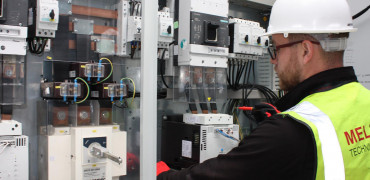The term ‘modular’ is increasingly heard in the construction sector, with a growing number of main contractors and housebuilders adopting this approach for faster and more efficient project delivery.
It’s also more common to hear the term applied to building services too.
Of course, the modular building services approach has been used in the UK for many years in the form of VRF air conditioning. VRF’s popularity is partly due to good energy performance.
But users also benefit from its modular set-up: if one VRF unit needs servicing or develops a fault, it affects only a small area of the occupied space, not the whole building.
Products are brought to site better prepared for efficient long-term operation
Connectivity and scalability
Modular chillers offer this same approach.
Instead of a large, single chiller, several smaller modules are connected to provide the end-user with the same level of output as the large, single chiller. An excellent example of this approach is the Mitsubishi Electric eSeries chiller.
Modular chillers make it easy to specify the exact chiller size required for a project, but with the reassurance that modular units can be scaled up to meet changing building requirements in the future.
Modular chillers also have multiple compressor circuits, so redundancy is built-in.
Pre-packaged and factory-tested
Modular products also benefit from the latest manufacturing methods.
At Mitsubishi Electric, this means applying our comprehensive quality control to ensure consistent and better build quality.
And our customers know that the modular chillers are pre-packaged, pre-piped, pre-wired and factory-tested before delivery.
Time is money
In today’s construction industry, time is money, so the ability to get modular products on-site and installed quickly is a significant advantage.
Small, lightweight modular chiller modules can be lifted onto rooftops far more easily and using less space than conventional chiller plant.
A typical modular chiller design sees a 35% space saving compared to a traditional chiller. And modular units can be positioned at 90 degrees to each other, so they fit conveniently into rooftop corners.
Ventilation systems are also benefiting from the modular approach.
Mechanical ventilation with heat recovery (MVHR) systems such as the Lossnay system is designed for commercial buildings and homes.
It can be installed in single rooms or as a whole system – making it ideal for refurbishment projects, where additional ventilation is required to improve occupant comfort.
Modern methods
A growing number of companies are adopting modern methods of construction (MMC), including the modular, prefabricated approach. Leading housebuilders and most of the UK’s leading contractors are making changes, and many of today’s largest construction projects use at least some element of MMC.
The government is helping to drive this change with requirements for MMC on public sector projects. But the shrinking pool of skilled on-site labour is also propelling the industry forward. Moreover, the potential cost savings are also an attractive incentive for an industry looking to improve its financial performance after a difficult two years.
The modular approach for building services such as air conditioning and ventilation means that products are brought to site better prepared for efficient long-term operation.
Installers can be confident that the products they install are of high quality, and end-users know their systems are more likely to perform effectively in the long term.
Check out our HVAC guide for more information about how HVAC systems work and their benefits.
Dave Archer is National M&E Manager


